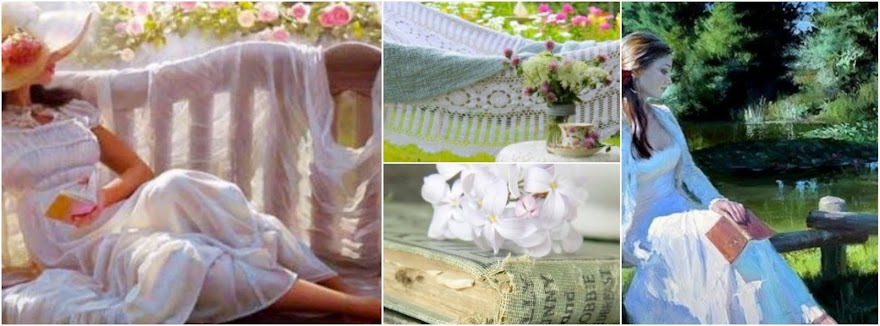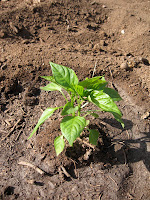I enjoyed visiting with my grandmother when I was a youngster on her farm and continued her way of life all through my days of growing up. From living on a small piece of land to 100 acres and now enjoying the land once again of 2 1/2 acres to farm, I simply find it very rewarding. Watching where food comes from, building up the soil, mulching and yes, weeding, too is all part of a gardener's life.
I have found preserving food to be ever so rewarding during the winter months especially to open up a jar of canned peaches or make a pot of soup with frozen green beans. There is nothing quite like the taste of a fresh picked tomato bursting in one's mouth.
So, I wonder if perhaps you've grown a potted cherry tomato on your patio or have planted rows of summer corn? Then how many of us have planted a zucchini mound only to discover later that one zucchini plant can feed your whole neighborhood squash for the entire summer?!
Besides visiting gardening blogs in my spare time, I also enjoy reading children's poems about gardens. And my favorite book to read by Juanita Havill ,
I Heard It from Alice Zucchini: Poems About the Garden
I love this book and found it so very imaginative and refreshing. Apparently others have, too. Take a look at these editorial reviews:
Copyright © American Library Association. All rights reserved
I found Alice Zucchini to be a lovely book and very well written. You'll find twenty whimsical poems celebrating the joys of a garden from start to finish. There's the Pea Pod Chant, Rhubarb Forest, dance with the Dainty Doily Dill Weed and gossip with Alice Zucchini is one of my favorites... so cleverly written and I love Juanita's imagination of the pumpkin's enchanted evening! The illustration's by Christine Davenier are superb!
Juanita Havill is the author of more than thirty books for children and young people, including Jamaica's Find, which won her the Ezra Jack Keats new Writer Award.

Tips for a Family Garden
The benefits of a garden are numerous. First of all, you get to save money on food. A garden is not just for flowers, although there are some that have edible leaves. In a garden you can grow fruits and vegetables which have been the staples of a healthy diet since humans first discovered them.
Number two, a garden is very eco-friendly. By growing your own food you save on trips to the grocery store which saves gas and decreases pollution. Also, fresh foods contain more of the vitamins and nutrients your body needs so you’ll be getting healthy.
Introduce your kids to nature in a way that shows how it directly benefits them. If you take the care to tend your garden, you will have delicious food to eat anytime. There’s nothing like feeling hungry and going outside to pluck a juicy red tomato off the vine.
Here are some tips for families who want to “go green” by producing their own food in a family garden.
I hope you enjoy your stay at LadyD Books.
Thanks for stopping by!
I have found preserving food to be ever so rewarding during the winter months especially to open up a jar of canned peaches or make a pot of soup with frozen green beans. There is nothing quite like the taste of a fresh picked tomato bursting in one's mouth.
So, I wonder if perhaps you've grown a potted cherry tomato on your patio or have planted rows of summer corn? Then how many of us have planted a zucchini mound only to discover later that one zucchini plant can feed your whole neighborhood squash for the entire summer?!
Besides visiting gardening blogs in my spare time, I also enjoy reading children's poems about gardens. And my favorite book to read by Juanita Havill ,
I Heard It from Alice Zucchini: Poems About the Garden
I love this book and found it so very imaginative and refreshing. Apparently others have, too. Take a look at these editorial reviews:
From School Library Journal
"Kindergarten-Grade 6-A bountiful harvest of lyrical poems that expresses delight in the world of nature. It is hard to resist singing such selections as Dainty Doily Dill Weed: Dainty Doily Dill Weed/dances in the breeze,/waving yellow blossoms,/calling to the peas. The poems are easily committed to memory due to their flawless rhythms and storytelling narratives. In Nursery Rhyme, the King of the Beetles and his queen, both wearing armor of golden green, will lose their home when the Rhubarb forest is baked in a pie. In another poem, a sweet but short marriage is arranged between a bee and Sweet Cicely, who laments, '-¦I flower in May,/in June, go away./How could we have enough time?' Havill knows how to craft a lullaby, a lyric to be sung, and a rhyme that begs chanting. Well suited to the charm of the verse, Davenier's pen-and-ink and watercolor illustrations transport readers to the ground level of the garden alongside mice, snails, crickets, and a busy young fairy. The book's arrangement reflects the cyclical movement from season to season. A table of contents offers 20 poems ripe for the picking from this first-choice book.-Teresa Pfeifer, Alfred Zanetti Montessori Magnet School, Springfield, MA "
Copyright © Reed Business Information, a division of Reed Elsevier Inc. All rights reserved.
Copyright © Reed Business Information, a division of Reed Elsevier Inc. All rights reserved.
From Booklist
"K-Gr. 3. As in George Shannon's Busy in the Garden (2006), Havill's collection of verse captures the science and backyard magic of growing things. Some selections are factual, even instructional: "Plant seeds early in the spring / when the ground is warm . . . Let the sun and rain pour down. / Be careful where you hoe." Others are filled with whimsy, as in a poem that suggests how worms navigate underground: "They switch on the light bulb radishes / and crawl in the beams of their glow." Davenier extends the fanciful imagery in scenes of lively, gossiping plants and animals, rendered in her signature watercolor-washed ink sketches. Children may feel puzzled when characters introduced in the poems aren't always pictured on the page, but a miniature, winged girl, who appears on each spread, provides visual continuity and amplifies the sense of enchantment. Fine choices for springtime poetry units, these selections offer excellent opportunities for studying sound, imagery, and poetry's range--from quiet reflections to boisterous chants--throughout the year. Gillian Engberg"Copyright © American Library Association. All rights reserved
Product Details
- Reading level: Ages 9-12
- Hardcover: 32 pages
- Publisher: Chronicle Books (February 23, 2006)
- Language: English
- ISBN-10: 0811839621
"In the still chill of a winter night seeds on the gardener's bench rattle their packets with chattering."
I found Alice Zucchini to be a lovely book and very well written. You'll find twenty whimsical poems celebrating the joys of a garden from start to finish. There's the Pea Pod Chant, Rhubarb Forest, dance with the Dainty Doily Dill Weed and gossip with Alice Zucchini is one of my favorites... so cleverly written and I love Juanita's imagination of the pumpkin's enchanted evening! The illustration's by Christine Davenier are superb!
Juanita Havill is the author of more than thirty books for children and young people, including Jamaica's Find, which won her the Ezra Jack Keats new Writer Award.
Garden Pot Craft Kit

Earth Day Flower Pot Craft
Then there's this neat activity for children to do in preparation for Earth Day!Color-Your-Own Papier-Mâché Earth Day Flowerpots
Oriental Trading Company
Tips for a Family Garden
Celebrating Earth Day and Going Green
Tips for a Family Garden
It seems that kids spend most of their time indoors playing video games or watching television these days. Want a way to get your kids off of the couch and save some money at the same time? Start a family garden.The benefits of a garden are numerous. First of all, you get to save money on food. A garden is not just for flowers, although there are some that have edible leaves. In a garden you can grow fruits and vegetables which have been the staples of a healthy diet since humans first discovered them.
Number two, a garden is very eco-friendly. By growing your own food you save on trips to the grocery store which saves gas and decreases pollution. Also, fresh foods contain more of the vitamins and nutrients your body needs so you’ll be getting healthy.
Introduce your kids to nature in a way that shows how it directly benefits them. If you take the care to tend your garden, you will have delicious food to eat anytime. There’s nothing like feeling hungry and going outside to pluck a juicy red tomato off the vine.
Here are some tips for families who want to “go green” by producing their own food in a family garden.
- Get everyone involved. Tilling the soil is a big job. The entire family can help prepare the ground for the garden.
- Read up on gardening. The reason so many people don’t have vegetable gardens is because they don’t know what’s involved. When you start without a plan, you are soon to fail.
- Decide what you will plant. Most gardens are begun at certain times of the year depending on what vegetables you choose and where you live.
- Use organic fertilizers and insect repellants. Organic gardening products are eco-friendly and allow you to eat foods right off the vine or out of the ground if you choose. Early settlers didn’t have chemical pesticides. Adding friendly insects to your garden, like ladybugs, will take care of undesirable pests without any chemicals.
- Weed the garden. Weeds can choke growing vegetables and ruin a garden. Regular weeding is a necessary part of bringing your vegetables to harvest. Take turns so no one feels like they are doing all the hard work themselves.
- Freeze or give away extra vegetables. You will have enough for the months when nothing is growing. Sharing your vegetables with friends and neighbors might inspire them to begin their own garden.
- Watch your garden grow. There’s nothing wrong with taking a daily tour of the garden with your kids. They can see the fruit of their labors as the vegetables enlarge and push through the soil. You have a front row seat to see nature at work.
I hope you enjoy your stay at LadyD Books.
Thanks for stopping by!






No comments:
Post a Comment
As always, so nice to hear from you!